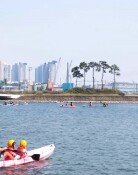S. Korea, U.S., Japan conduct a missile defense drill
S. Korea, U.S., Japan conduct a missile defense drill
Posted March. 15, 2017 07:08,
Updated March. 15, 2017 07:16
The Republic of Korea Army announced on Tuesday that the Aegis-equipped vessel of Korea, the U.S., and Japan will conduct a missile defense drill on Wednesday at the seas nearby South Korea and Japan to prevent the North's possible ballistic missile launch.
As the fourth drill to be held since June last year, the three countries will detect and share intelligence on the flight orbit of virtual target (or North Korean missile) backed by computer simulation on the Aegis vessel. South Korea’s The King Sejong, Japan’s Maritime Self-Defense Force Kirishima, and the American USS Curtis Wilbur will participate in this drill.
“The drill will provide an opportunity for the three countries to enforce military coordination in prevention of all North Korean missile threats, from scud-ER to Intercontinental Ballistic Missile (ICBM) and Submarine-Launched Ballistic Missile (SLBM),” explained a Korean military official. At the current time, the Aegis vessels operated by three nations are equipped with “vigilant eyes (or radar),” which can track ballistic missiles flying eight-times faster than the speed of sound beyond a maximum of 1,000 kilometers.
Still, in terms of intercepting technology, there is a long way to go for the South Korean Aegis vessel compared to the counterparts of the U.S. and Japan. At the current time, the American and Japanese vessels are deployed with dozens of SM-3 intercepting missiles, which can track and strike ballistic missiles flying over 150-500 kilometers high. This means that the two vessels can deal an instant “heavy blow” once it immediately detects missiles with nuclear warheads. It is also reported that the two vessels will also arrange a modified SM-3 missiles with a maximum intercept altitude at 1,200 kilometers for combat purposes.
Sang-Ho Yun ysh1005@donga.com







